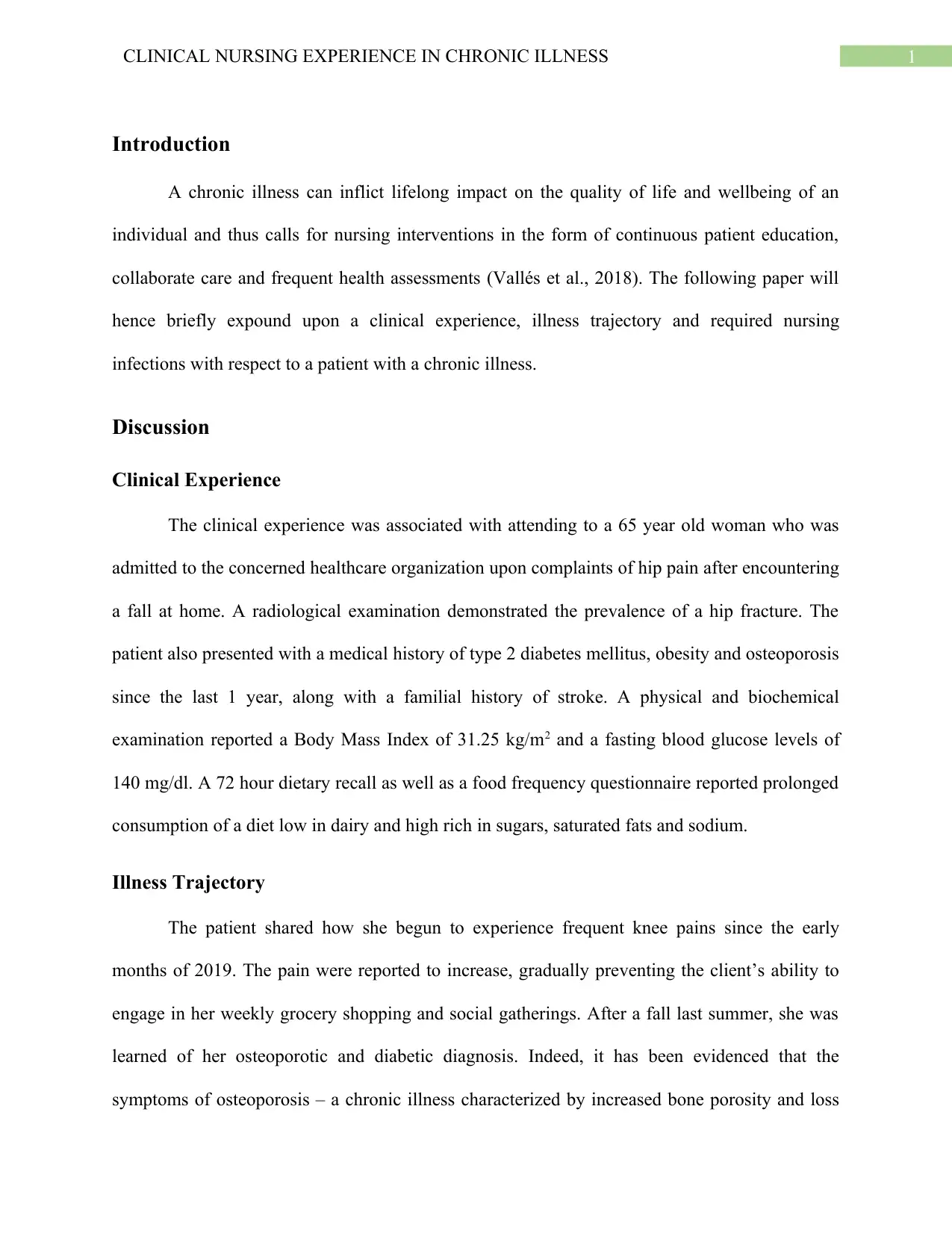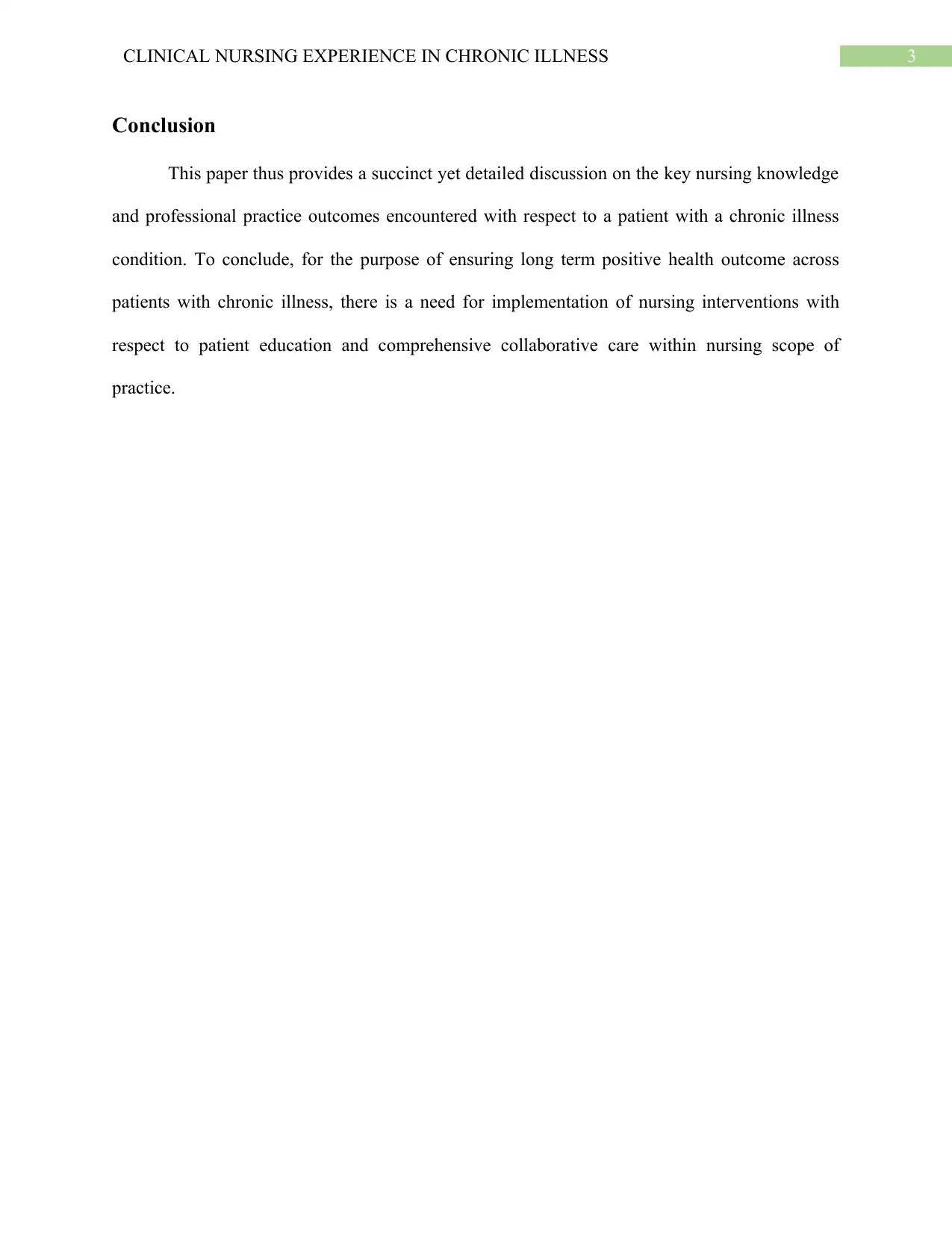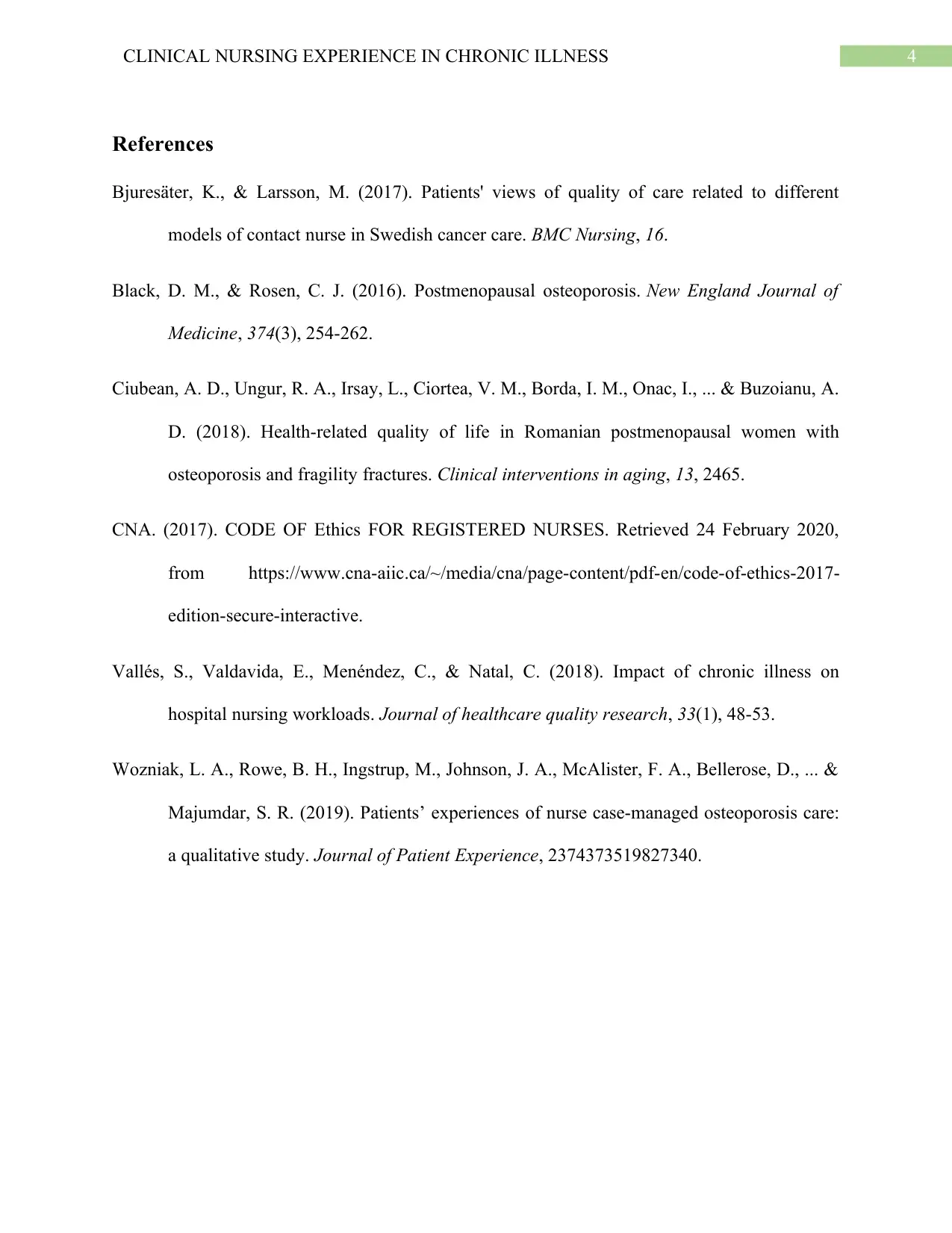University Nursing Report: Clinical Experience in Chronic Illness
VerifiedAdded on 2022/08/12
|5
|943
|20
Report
AI Summary
This report details a clinical nursing experience involving a 65-year-old woman admitted with a hip fracture, complicated by type 2 diabetes, obesity, and osteoporosis. The report explores the patient's illness trajectory, highlighting the gradual onset of symptoms and the impact on her daily life and quality of life. It identifies areas of neglected nursing care, such as patient education on diet and the importance of collaborative care, referencing violations of the Canadian Nurses Association's Code of Ethics. The paper emphasizes the need for comprehensive nursing interventions, including patient education and collaborative care, to ensure positive long-term health outcomes for patients with chronic illnesses, and provides references to support the findings.

Running head: CLINICAL NURSING EXPERIENCE IN CHRONIC ILLNESS
CLINICAL NURSING EXPERIENCE IN CHRONIC ILLNESS
Name of the Student:
Name of the University:
Author note:
CLINICAL NURSING EXPERIENCE IN CHRONIC ILLNESS
Name of the Student:
Name of the University:
Author note:
Paraphrase This Document
Need a fresh take? Get an instant paraphrase of this document with our AI Paraphraser

1CLINICAL NURSING EXPERIENCE IN CHRONIC ILLNESS
Introduction
A chronic illness can inflict lifelong impact on the quality of life and wellbeing of an
individual and thus calls for nursing interventions in the form of continuous patient education,
collaborate care and frequent health assessments (Vallés et al., 2018). The following paper will
hence briefly expound upon a clinical experience, illness trajectory and required nursing
infections with respect to a patient with a chronic illness.
Discussion
Clinical Experience
The clinical experience was associated with attending to a 65 year old woman who was
admitted to the concerned healthcare organization upon complaints of hip pain after encountering
a fall at home. A radiological examination demonstrated the prevalence of a hip fracture. The
patient also presented with a medical history of type 2 diabetes mellitus, obesity and osteoporosis
since the last 1 year, along with a familial history of stroke. A physical and biochemical
examination reported a Body Mass Index of 31.25 kg/m2 and a fasting blood glucose levels of
140 mg/dl. A 72 hour dietary recall as well as a food frequency questionnaire reported prolonged
consumption of a diet low in dairy and high rich in sugars, saturated fats and sodium.
Illness Trajectory
The patient shared how she begun to experience frequent knee pains since the early
months of 2019. The pain were reported to increase, gradually preventing the client’s ability to
engage in her weekly grocery shopping and social gatherings. After a fall last summer, she was
learned of her osteoporotic and diabetic diagnosis. Indeed, it has been evidenced that the
symptoms of osteoporosis – a chronic illness characterized by increased bone porosity and loss
Introduction
A chronic illness can inflict lifelong impact on the quality of life and wellbeing of an
individual and thus calls for nursing interventions in the form of continuous patient education,
collaborate care and frequent health assessments (Vallés et al., 2018). The following paper will
hence briefly expound upon a clinical experience, illness trajectory and required nursing
infections with respect to a patient with a chronic illness.
Discussion
Clinical Experience
The clinical experience was associated with attending to a 65 year old woman who was
admitted to the concerned healthcare organization upon complaints of hip pain after encountering
a fall at home. A radiological examination demonstrated the prevalence of a hip fracture. The
patient also presented with a medical history of type 2 diabetes mellitus, obesity and osteoporosis
since the last 1 year, along with a familial history of stroke. A physical and biochemical
examination reported a Body Mass Index of 31.25 kg/m2 and a fasting blood glucose levels of
140 mg/dl. A 72 hour dietary recall as well as a food frequency questionnaire reported prolonged
consumption of a diet low in dairy and high rich in sugars, saturated fats and sodium.
Illness Trajectory
The patient shared how she begun to experience frequent knee pains since the early
months of 2019. The pain were reported to increase, gradually preventing the client’s ability to
engage in her weekly grocery shopping and social gatherings. After a fall last summer, she was
learned of her osteoporotic and diabetic diagnosis. Indeed, it has been evidenced that the
symptoms of osteoporosis – a chronic illness characterized by increased bone porosity and loss

2CLINICAL NURSING EXPERIENCE IN CHRONIC ILLNESS
of bone density – gradually remain undetected and emerge as a result of prolonged engagement
in poor lifestyle and dietary behaviors, especially in postmenopausal women (Black & Rosen,
2016).
Impact on Daily Function and Quality of Life
Often hinders an individual’s mobility due to resultant pains and risk of falls resulting in
reduced socialization. The gradual loss of social interaction and need for assistance further inflict
feelings of pessimism and social exclusion in the individual. Indeed, upon questioning, the
patient admitted to feeling depressed and lonely frequently due to her inability to engage in her
once pleasurable activities of shopping and groceries (Ciubean et al., 2018).
Areas of Neglect
Nursing are obliged to engage in continuous and comprehensive education comprising of
enlightening patients on the severity, prevention, treatment and management of chronic illness.
This seemed to have been neglected in the given case since despite the last diagnosis, the patient
continued to be quite unaware of the role of diet and engaged in unhealthy dietary consumption
(Bjuresäter & Larsson, 2017). Additionally, nurses must also collaborate care with other
healthcare professionals which was neglected in this case, since the previous diagnosis
demonstrated no mention of the cardiovascular history of the patient and was found out only
shared verbally by the patient. Collaborative care holds equal importance for the management for
long term morbidities in chronic illnesses (Wozniak et al., 2019). Such neglect demonstrate
violations of standards 6 and 7 of the Code of Ethics by the Canadian Nurses Association (CAN,
2017).
of bone density – gradually remain undetected and emerge as a result of prolonged engagement
in poor lifestyle and dietary behaviors, especially in postmenopausal women (Black & Rosen,
2016).
Impact on Daily Function and Quality of Life
Often hinders an individual’s mobility due to resultant pains and risk of falls resulting in
reduced socialization. The gradual loss of social interaction and need for assistance further inflict
feelings of pessimism and social exclusion in the individual. Indeed, upon questioning, the
patient admitted to feeling depressed and lonely frequently due to her inability to engage in her
once pleasurable activities of shopping and groceries (Ciubean et al., 2018).
Areas of Neglect
Nursing are obliged to engage in continuous and comprehensive education comprising of
enlightening patients on the severity, prevention, treatment and management of chronic illness.
This seemed to have been neglected in the given case since despite the last diagnosis, the patient
continued to be quite unaware of the role of diet and engaged in unhealthy dietary consumption
(Bjuresäter & Larsson, 2017). Additionally, nurses must also collaborate care with other
healthcare professionals which was neglected in this case, since the previous diagnosis
demonstrated no mention of the cardiovascular history of the patient and was found out only
shared verbally by the patient. Collaborative care holds equal importance for the management for
long term morbidities in chronic illnesses (Wozniak et al., 2019). Such neglect demonstrate
violations of standards 6 and 7 of the Code of Ethics by the Canadian Nurses Association (CAN,
2017).
⊘ This is a preview!⊘
Do you want full access?
Subscribe today to unlock all pages.

Trusted by 1+ million students worldwide

3CLINICAL NURSING EXPERIENCE IN CHRONIC ILLNESS
Conclusion
This paper thus provides a succinct yet detailed discussion on the key nursing knowledge
and professional practice outcomes encountered with respect to a patient with a chronic illness
condition. To conclude, for the purpose of ensuring long term positive health outcome across
patients with chronic illness, there is a need for implementation of nursing interventions with
respect to patient education and comprehensive collaborative care within nursing scope of
practice.
Conclusion
This paper thus provides a succinct yet detailed discussion on the key nursing knowledge
and professional practice outcomes encountered with respect to a patient with a chronic illness
condition. To conclude, for the purpose of ensuring long term positive health outcome across
patients with chronic illness, there is a need for implementation of nursing interventions with
respect to patient education and comprehensive collaborative care within nursing scope of
practice.
Paraphrase This Document
Need a fresh take? Get an instant paraphrase of this document with our AI Paraphraser

4CLINICAL NURSING EXPERIENCE IN CHRONIC ILLNESS
References
Bjuresäter, K., & Larsson, M. (2017). Patients' views of quality of care related to different
models of contact nurse in Swedish cancer care. BMC Nursing, 16.
Black, D. M., & Rosen, C. J. (2016). Postmenopausal osteoporosis. New England Journal of
Medicine, 374(3), 254-262.
Ciubean, A. D., Ungur, R. A., Irsay, L., Ciortea, V. M., Borda, I. M., Onac, I., ... & Buzoianu, A.
D. (2018). Health-related quality of life in Romanian postmenopausal women with
osteoporosis and fragility fractures. Clinical interventions in aging, 13, 2465.
CNA. (2017). CODE OF Ethics FOR REGISTERED NURSES. Retrieved 24 February 2020,
from https://www.cna-aiic.ca/~/media/cna/page-content/pdf-en/code-of-ethics-2017-
edition-secure-interactive.
Vallés, S., Valdavida, E., Menéndez, C., & Natal, C. (2018). Impact of chronic illness on
hospital nursing workloads. Journal of healthcare quality research, 33(1), 48-53.
Wozniak, L. A., Rowe, B. H., Ingstrup, M., Johnson, J. A., McAlister, F. A., Bellerose, D., ... &
Majumdar, S. R. (2019). Patients’ experiences of nurse case-managed osteoporosis care:
a qualitative study. Journal of Patient Experience, 2374373519827340.
References
Bjuresäter, K., & Larsson, M. (2017). Patients' views of quality of care related to different
models of contact nurse in Swedish cancer care. BMC Nursing, 16.
Black, D. M., & Rosen, C. J. (2016). Postmenopausal osteoporosis. New England Journal of
Medicine, 374(3), 254-262.
Ciubean, A. D., Ungur, R. A., Irsay, L., Ciortea, V. M., Borda, I. M., Onac, I., ... & Buzoianu, A.
D. (2018). Health-related quality of life in Romanian postmenopausal women with
osteoporosis and fragility fractures. Clinical interventions in aging, 13, 2465.
CNA. (2017). CODE OF Ethics FOR REGISTERED NURSES. Retrieved 24 February 2020,
from https://www.cna-aiic.ca/~/media/cna/page-content/pdf-en/code-of-ethics-2017-
edition-secure-interactive.
Vallés, S., Valdavida, E., Menéndez, C., & Natal, C. (2018). Impact of chronic illness on
hospital nursing workloads. Journal of healthcare quality research, 33(1), 48-53.
Wozniak, L. A., Rowe, B. H., Ingstrup, M., Johnson, J. A., McAlister, F. A., Bellerose, D., ... &
Majumdar, S. R. (2019). Patients’ experiences of nurse case-managed osteoporosis care:
a qualitative study. Journal of Patient Experience, 2374373519827340.
1 out of 5
Your All-in-One AI-Powered Toolkit for Academic Success.
+13062052269
info@desklib.com
Available 24*7 on WhatsApp / Email
![[object Object]](/_next/static/media/star-bottom.7253800d.svg)
Unlock your academic potential
Copyright © 2020–2025 A2Z Services. All Rights Reserved. Developed and managed by ZUCOL.


